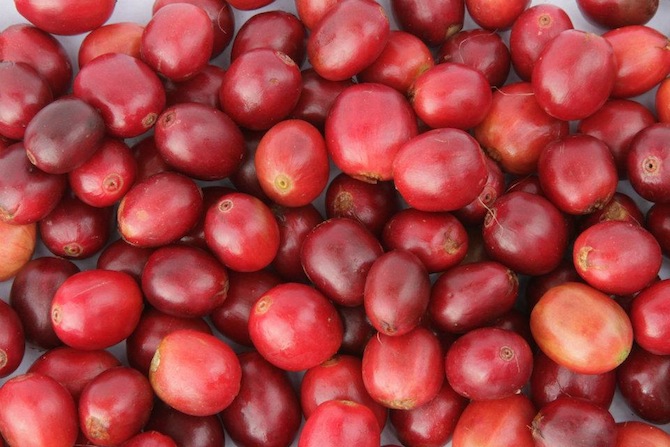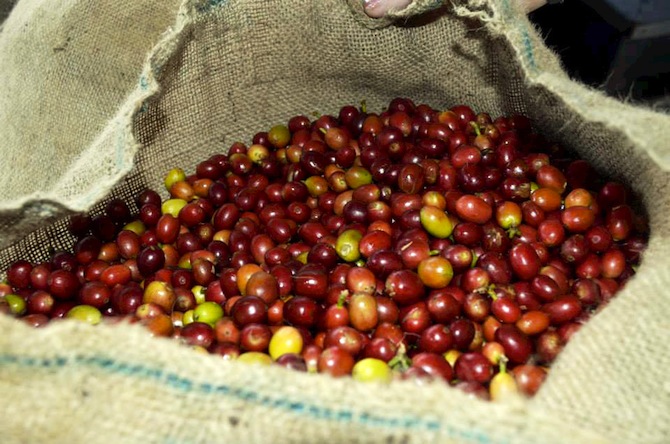
Most of us can’t make it through the busy work day without a cup of coffee. But while coffee does have health benefits — some of which include protecting against Parkinson’s Disease, preventing liver disease and reducing your risk of certain cancers — the real antioxidant punch is found in what’s taken off the coffee cherries during production: the skins.
During a tour of Greenwell Farms — one of Kona, Hawaii‘’s oldest and largest coffee producers — I was able to see exactly how Kona’s complex yet smooth coffee was produced. Over 300 local farmers work the 70 acres (25 hectares) of Greenwell’s land, hand-picking coffee cherries, which look more like sweet fruit than the bitter java you find in your stainless steel thermos.
My tour guide, Peggy, jokes that visitors are always amazed at how many “cherries” they grow; however, while Greenwell Farms grows a large variety of fruits, none of them are cherries. When people look at the ruby red balls growing in bunches on the coffee trees, they’re actually seeing the outside of the coffee bean (or seed) — which also happens to be a secret superfood.

Farm-To-Bottle
While coffee cherry skins mar the taste of coffee, they provide a major boost for your health. In fact, these juicy, sweet skins pack eight time the antioxidants of blueberries, meaning you don’t need to worry about making a complex salad or juicing to get a solid health boost.
Like many coffee growers, Greenwell Farms had been using their coffee cherry skins as fertilizer, not realizing they were wasting something extremely valuable. This is especially true as Kona coffee plants not only produce some of the world’s best coffee, but coffee cherries, due to the destination’s rich volcanic soil; mix of sun, rain and dependable afternoon cloud cover; elevation between 500 and 3,000 feet (152 to 914 meters); and sloping for root drainage. What’s amazing is these coffee cherries, with their immune-boosting, anti-inflammatory and anti-viral properties, have been growing right under growers’ noses for over 175 years.
For those who don’t have access to recycled coffee cherries, KonaRed, a Hawaii-based company, developed a series of antioxidant-rich juices based on the health benefits of the local coffee cherry, which is where Greenwell Farms now donates their skins.
“We spent months in the lab, identifying the marker compounds and antioxidants in the coffee cherry from Kona, Hawaii,” explains Shaun Roberts, co-founder and CEO of KonaRed. “Our test results from leading antioxidant testing firms like Brunswick Laboratories and Chromadex identified these compounds and antioxidants and the levels contained in coffee fruit.”
Taking the coffee cherries, KonaRed has developed a line of health products, great for those on the go. To create their juices, the cherry skins are dried and compressed into a liquid, using “only the ripe red fruit, the whole fruit and nothing but the fruit.” And while the promise of instant energy may lead you to believe it’s an energy drink, KonaRed has no added sugar or caffeine, just a naturally-occurring 18 to 40 milligrams per serving, depending on which juice you sip. According to the company, the vitality you feel is based solely on the vitamins and antioxidants, which also helps to protect against free-radicals, disease and anti-aging.
Not only that, but by paying local farmers for something that was previously discarded they’re doing something sustainable and helping the economy. And while the idea of farm-to-table is nothing new in 2014, they’re spotlighting farm-to-bottle, something drinkers not only taste but feel as they experience an energy boost from the natural antioxidants of the coffee fruit.

Beyond Antioxidants
While consuming high levels of antioxidants is great for health and beauty, antioxidant marketing has been done to death, as we’ve seen in the past with POM Wonderful, Kellogg’s FiberPlus Cereals, Hershey’s Special Dark Cocoa and even 7UP when they added vitamins to certain soft drinks.
“In general “antioxidants” are needed to balance the effects of “oxidants” — which are highly reactive oxygen molecules that can interact with and cause damage to cells and cellular structures like membranes, mitochondria and DNA,” explains Nutritional Biochemist with SupplementWatch and author Dr. Shawn Talbott. “Antioxidants serve as a layer of cellular protection between the oxidants and the delicate cellular structures in all of our tissues — so antioxidants can “intercept” (or “quench”) the damaging oxidative properties of oxidants.”
For this reason, KonaRed has also focused on coffee cherries’ high Oxygen Radical Absorbance Capacity (ORAC). ORAC refers to antioxidant activity and its ability to protect at the cellular level. The human body contains five main reactive species: peroxyl radicals, hydroxyl radicals, peroxynitrite, super oxide anion, and singlet oxygen. When testing for ORAC, you can see how well a food or drink can protect against these five species.
To run the test, food samples are placed in test tubes with free radical-generating molecules as well as molecules that can be oxidized. Through this test, researchers can determine how well the food sample is able to protect the susceptible molecules from being oxidized by the free radicals.
According to a study provided by KonaRed done by Brunswick Laboratories, KonaRed received a total score of 2,501.04 per gram, or 7,900 ORAC units per serving. That is higher than well-known superfoods like acai, pomegranates and even blueberries. Extensive research has also been done by Dr. Ronald Prior, who began his research with the U.S. Department of Agriculture and now does independent consulting and research on ORAC, as well as Dr. Guohua Cao , who at the time of researching was working at the National Institutes of Health in the Aging Institute in Baltimore and who developed the chemical assay at the core of the ORAC. According to them, adults should get about 10 to 12,000 ORAC units per day (defined as micromoles of Trolox Equivalents of ORAC using the peroxyl radical), making KonaRed and other coffee cherry products a great choice for those needing a powerful boost.

Coffee Cherries For Beauty
It’s not just beverages – beauty product purveyors are trying to cash in on coffee fruit skins, too. Dermatologist Debbie Palmer has a skincare line, REPLERE, that infuses coffee cherries as a raw ingredient.
What’s interesting is how many people are unaware coffee is the mostly widely-consumed antioxidant and the top source for antioxidants in the United States.
“To this day, the coffee fruit or cherry is handpicked on coffee farms, as it has been done for over 1,000 years, and farmers will tell you that the fruit is rejuvenating—and those who pick it have younger looking hands,” explains Palmer. “It is with this knowledge that I tested the antioxidant potency of the cherry skin and pulp and discovered its strength and effectiveness– through a double-blind, randomized, controlled trial and ORAC testing. ORAC testing has also been done on the coffee cherry demonstrating its superior performance of neutralizing free radicals. It has been shown to be a stronger antioxidant than green tea, vitamin C and E.”

The Future
So what can people expect for the future of coffee cherries and KonaRed? Along with more brands in the food, healthcare and beauty industry utilizing their powerful effects — including a number of coffee cherry teas, juices and sodas — KonaRed will continue to grow its product.
“We are building out our distribution network and retail footprint for our beverages in 2014 — two new flavors for the show — and soon to be introduced nutritionals at Expo West in Anaheim, CA this week.” explains Roberts. “We will work hard to educate the consumer about the brand and the category of coffee fruit from Kona, HI. Who knew coffee beans came from a fruit? This is our job to tell people.”
If a recent $12 million investment from Chicago-based institutional investor Lincoln Park Capital, slew of new distributors and partnership with VDF FutureCeuticals are any indication, it looks like their voice will be heard.
Have you tried coffee cherries in either food, drink or beauty product form? What did you think? Please share in the comments below?

Jessica Festa is the editor of the travel sites Jessie on a Journey (http://jessieonajourney.com) and Epicure & Culture (http://epicureandculture.com). Along with blogging at We Blog The World, her byline has appeared in publications like Huffington Post, Gadling, Fodor’s, Travel + Escape, Matador, Viator, The Culture-Ist and many others. After getting her BA/MA in Communication from the State University of New York at Albany, she realized she wasn’t really to stop backpacking and made travel her full time job. Some of her most memorable experiences include studying abroad in Sydney, teaching English in Thailand, doing orphanage work in Ghana, hiking her way through South America and traveling solo through Europe. She has a passion for backpacking, adventure, hiking, wine and getting off the beaten path.








